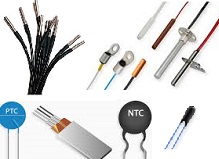Temperature Sensor - The Thermistor
 Thermistors (short for thermal resistors) are very simple, discrete two-terminal solid-state devices whose resistance values change with temperature—enough to measure the change with the correct circuitry. They follow Ohm’s law, just like a resistor, except that a thermistor’s resistance value will vary depending on the temperature to which the device is exposed.Thermistors and thermocouples are two such temperature sensors. A thermistor is a thermally sensitive resistor that exhibits a continuous, small, incremental change in resistance correlated to temperature variations.
Thermistors (short for thermal resistors) are very simple, discrete two-terminal solid-state devices whose resistance values change with temperature—enough to measure the change with the correct circuitry. They follow Ohm’s law, just like a resistor, except that a thermistor’s resistance value will vary depending on the temperature to which the device is exposed.Thermistors and thermocouples are two such temperature sensors. A thermistor is a thermally sensitive resistor that exhibits a continuous, small, incremental change in resistance correlated to temperature variations.
Thermistors are electronic devices that exhibit a change in electrical resistance with a change in temperature. They are commonly used as temperature sensors due to their sensitivity and ability to provide accurate temperature measurements over a wide range. Here's how thermistors can be effectively used as temperature sensors:
Thermistors alter their resistance with temperature. Using different semiconductor materials and fabrication processes, thermistors can carry either a NTC or a PTC. As the temperature increases, NTC thermistors decrease their resistance value, while PTC thermistors increase their resistance value. NTC thermistors have been around for many decades and have become the default component for thermistorbased temperature sensing because of their low price point. Nonlinear PTC thermistors are typically used for current-limiting applications due to their rapid increase of resistance beginning at a specific temperature. Because of this characteristic, nonlinear PTC thermistors are commonly referred to as “switching PTC thermistors.”
-
Resistance-Temperature Relationship:
- Thermistors are designed to have a predictable and nonlinear resistance-temperature relationship. The resistance of a thermistor decreases with an increase in temperature. This characteristic makes them suitable for temperature sensing applications.
-
Steinhart-Hart Equation:
- The Steinhart-Hart equation is commonly used to describe the resistance-temperature characteristics of a thermistor. It is a mathematical model that allows for accurate conversion between resistance and temperature. The equation is often used in microcontroller-based systems to obtain precise temperature readings.
-
Types of Thermistors:
- There are two main types of thermistors: NTC (Negative Temperature Coefficient) and PTC (Positive Temperature Coefficient).
- NTC Thermistors: The resistance of NTC thermistors decreases with an increase in temperature. They are widely used for temperature sensing applications, especially in temperature control systems.
- PTC Thermistors: The resistance of PTC thermistors increases with an increase in temperature. PTC thermistors are used in applications where a rise in temperature needs to be detected, such as overcurrent protection.
- There are two main types of thermistors: NTC (Negative Temperature Coefficient) and PTC (Positive Temperature Coefficient).
-
Temperature-Compensating Circuits:
- Thermistors are often used in temperature-compensating circuits to provide accurate temperature measurements. These circuits may include resistors and components that work together to compensate for the nonlinear characteristics of the thermistor.
-
Voltage Divider Circuits:
- One common method of using a thermistor as a temperature sensor is in a voltage divider circuit. By placing the thermistor in series with a fixed resistor, the voltage across the thermistor can be measured. As the temperature changes, the resistance of the thermistor changes, leading to a variation in the voltage across it.
-
Microcontroller-Based Systems:
- Thermistors are frequently integrated into microcontroller-based systems. A microcontroller can measure the resistance of the thermistor, apply the Steinhart-Hart equation, and calculate the corresponding temperature. This digital temperature data can then be used for various applications, such as temperature monitoring or control.
-
Temperature Compensation:
- In electronic devices and circuits, thermistors are used for temperature compensation. They help stabilize the performance of components and systems by adjusting for temperature-induced variations.
-
Medical and Industrial Applications:
- Thermistors are employed in various industries, including medical and industrial applications. They are used in temperature-sensitive equipment, such as incubators, HVAC systems, temperature-controlled ovens, and other devices where precise temperature monitoring is essential.
-
High Accuracy and Precision:
- Thermistors can offer high accuracy and precision in temperature measurements, making them suitable for applications where fine temperature control or monitoring is critical.
-
Environmental Monitoring:
- Thermistors are used in environmental monitoring systems to measure ambient temperature. This is valuable in applications such as weather stations, greenhouses, and climate-controlled environments.
Thermistors are versatile temperature sensors that find extensive use in various industries and applications due to their sensitivity, accuracy, and nonlinear resistance-temperature relationship. Their integration into electronic circuits and systems allows for effective temperature monitoring and control.